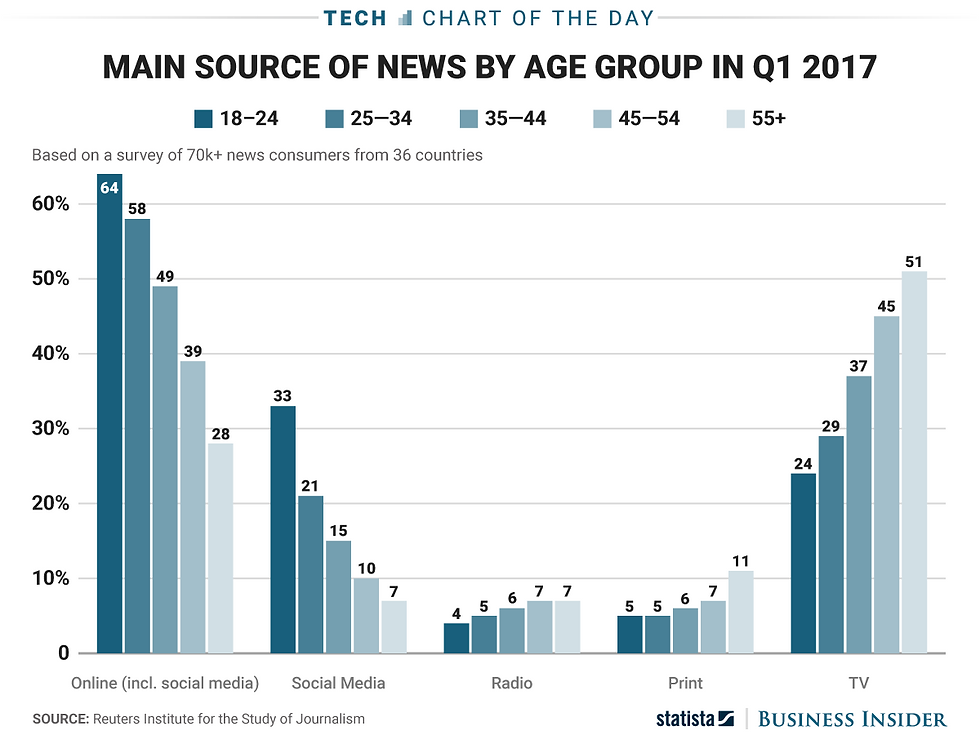A Reflection on Multi-Platform Broadcasting
- Mikaela

- Jun 4, 2018
- 2 min read
Updated: Oct 25, 2021
Today’s society is living in what is known as the digital age. We are more reliant than ever before on our technology and for that it is continuously evolving. Technology is apart of almost everything we do now and that doesn’t stop in the workplace even in journalism.
Journalism has many core values and skills that can’t be helped or taught with technology. They are basic writing skills and knowing how to write for your audience, whoever they may be. This is an adaptable skill that changes depending on who you’re writing for, what you’re writing for and the topic you are writing about.
Traditionally, you would’ve had to switch on the radio or the television to hear any kind of local, national or international news. This has now drastically changed thanks to our ever evolving technology and the creation of multiple media platforms. Social media is a now a tool for journalists and broadcasting companies to push their stories to reach a broader audience.
Social media is the millennial way of sharing one’s life with the world seeking attention and approval in the form of views, likes, and followers. For the journalism industry using social media can be very advantageous, news broadcasting is no longer limited. There are a multitude of social media platforms but for journalists the key ones are Facebook, Twitter, Snapchat, and Instagram. This is a way to promote your stories and news articles, and really be able to reach a larger and much broader audience.

In an article about how different generations interact with a variety of sources of news, Dunn (2017) discovered that old fashioned sources like radio, print and even TV are not as popular with people aged 34 and below as they are with older people aged 45 and up.
This digital age has seen a boom in blogging with many people taking it upon themselves to self publish blogs and video content. Blogs these days are majorly based on personal opinion, and advice. However, they have proven popular due to what Newman (2009) describes as the informal and the personal side of blogging. People want to be able to connect with what they are reading and they to be able to relate to it.
I found with the process of using multi-platform broadcasting with the assessments in this unit it reached a wider audience. When I conducted my live video on Facebook I found that it received greater views than my previous video post/link to YouTube. The best thing about using social media as platforms to promote my work as an amateur journalist it makes it easier and more efficient to see the statistics of how my posts are doing and what people are enjoying more. However, there are some forms of social media I didn’t enjoy using mainly the Facebook live, it was uncomfortable and provided nothing to the story I was covering. Facebook lives like that should be left to the social media influencers of the world.
References
Dunn, J. (2017). The difference between how millennials and baby boomers consume news, in one chart. Business Insider Australia. Retrieved from https://www.businessinsider.com.au/how-millennials-vs-baby-boomers-get-news-chart-2017-6?r=US&IR=T
Newman, N. (2009). The Rise of Social Media and its impact on mainstream journalism [PDF]. Oxford, England: University of Oxford. Retrieved from https://reutersinstitute.politics.ox.ac.uk/sites/default/files/2017-11/The%20rise%20of%20social%20media%20and%20its%20impact%20on%20mainstream%20journalism.pdf


Comments